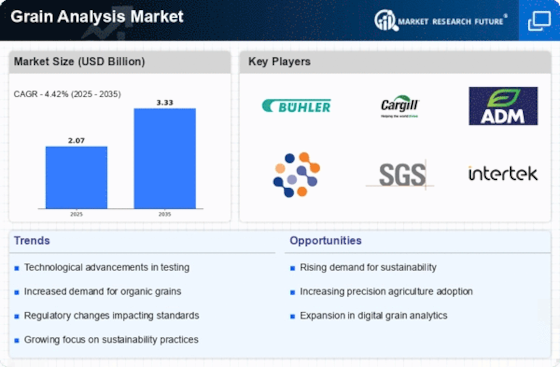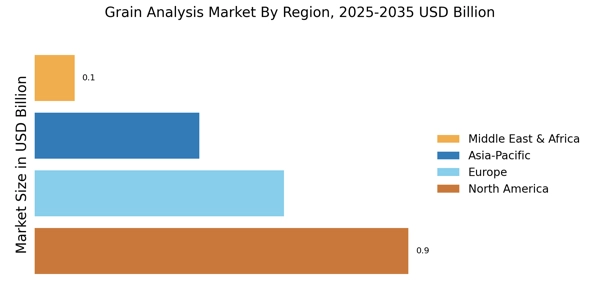Global Trade Dynamics and Grain Quality
The dynamics of international trade are exerting a considerable influence on the Grain Analysis Market. As countries engage in the export and import of grains, the quality of these products becomes paramount. Trade agreements often stipulate specific quality standards that must be met, necessitating thorough grain analysis. Recent statistics indicate that the volume of grain traded internationally is on the rise, which in turn amplifies the need for reliable testing services. This trend is particularly evident in regions where grain production is a key economic driver. Consequently, the Grain Analysis Market is likely to experience growth as exporters and importers seek to ensure compliance with international quality standards, thereby enhancing their competitiveness in the global market.
Rising Awareness of Food Safety Standards
The heightened awareness surrounding food safety is significantly influencing the Grain Analysis Market. Consumers are increasingly concerned about the quality and safety of their food, prompting regulatory bodies to enforce stricter safety standards. This trend is reflected in the growing demand for comprehensive grain analysis to detect contaminants such as mycotoxins and pesticide residues. According to recent data, the market for grain testing services is projected to expand as food manufacturers and distributors prioritize safety compliance. The emphasis on traceability and transparency in food supply chains further underscores the necessity for rigorous grain analysis. Consequently, this driver is likely to propel the growth of the Grain Analysis Market, as stakeholders invest in reliable testing solutions to meet consumer expectations and regulatory requirements.
Sustainability Initiatives in Agriculture
Sustainability initiatives are increasingly shaping the Grain Analysis Market. As agricultural practices evolve, there is a growing emphasis on sustainable farming methods that minimize environmental impact. This shift is driving the need for grain analysis to assess the sustainability of farming practices, including soil health and crop rotation effects. Data suggests that consumers are more inclined to purchase products that are certified as sustainably sourced, prompting producers to invest in grain testing to validate their claims. The integration of sustainability metrics into grain analysis not only supports environmental goals but also enhances marketability. As sustainability becomes a core focus for agricultural stakeholders, the Grain Analysis Market is poised for growth, driven by the demand for responsible and transparent practices.
Technological Integration in Grain Analysis
The integration of advanced technologies in the Grain Analysis Market is transforming traditional practices. Innovations such as artificial intelligence, machine learning, and automation are enhancing the accuracy and efficiency of grain testing processes. For instance, the use of near-infrared spectroscopy (NIRS) allows for rapid analysis of grain composition, which is crucial for quality control. As a result, the market is witnessing a shift towards more sophisticated analytical tools that can provide real-time data. This technological evolution not only improves operational efficiency but also reduces costs associated with manual testing. The increasing adoption of these technologies is expected to drive growth in the Grain Analysis Market, as stakeholders seek to optimize their supply chains and ensure compliance with stringent quality standards.
Increased Investment in Agricultural Research
Investment in agricultural research is a pivotal driver for the Grain Analysis Market. Governments and private entities are recognizing the importance of research in enhancing crop yields and improving grain quality. This focus on research and development is leading to the creation of innovative grain analysis methods that can better assess nutritional content and detect diseases. For example, advancements in genomic analysis are enabling more precise evaluations of grain varieties. As funding for agricultural research continues to rise, the Grain Analysis Market is expected to benefit from the introduction of new analytical techniques and tools. This trend not only supports the agricultural sector but also aligns with the growing demand for high-quality grains in food production.


















Leave a Comment